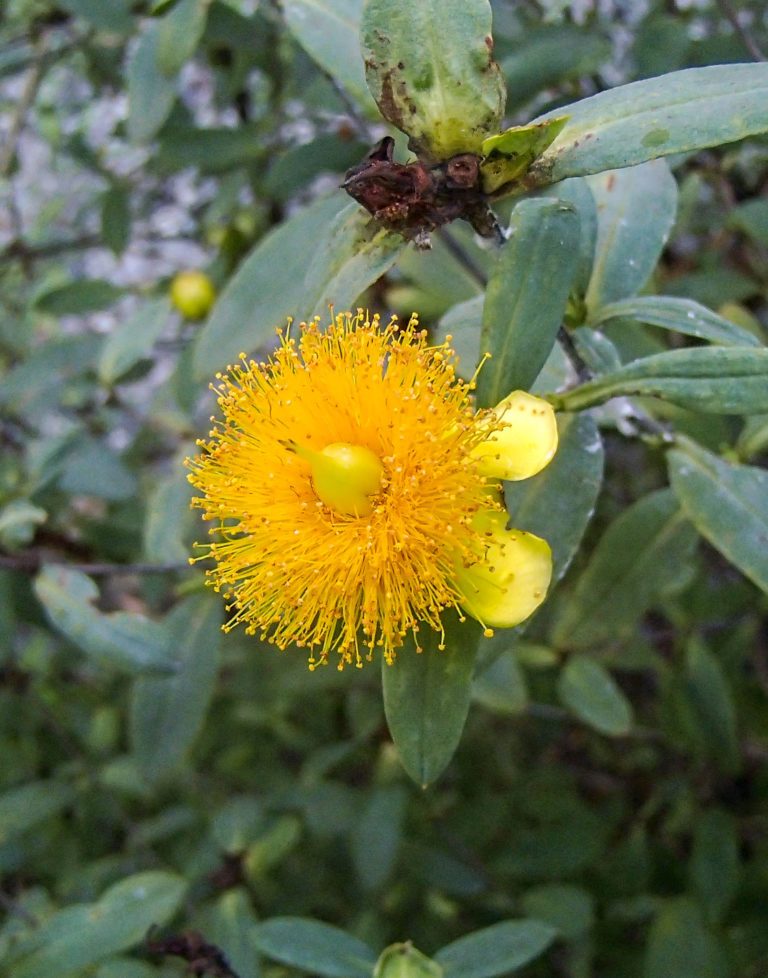Hypericum frondosum, or Golden St. Johnswort (the species) is a small, semi-woody shrub which grows in states all across the Southeast, but is not common. In NC, it is reported to occur in only two counties (in the mountains). Nevertheless, it thrives in our hot and humid piedmont, and should be considered for a shrub border or specimen because it is beautiful. Golden St. Johnswort is 3-4 feet high x 3-4 feet wide, sun-loving, straight-stemmed, with bluish-green, deciduous foliage, reddish, flaky bark on mature stems, and attractive, bright golden-yellow flowers in mid-season which attract many pollinators. The opposite leaves of Golden St. Johnswort are evergreen to semi-evergreen in the southern part of its growing range. In fall the plant is pretty too, with purplish leaves and covered with masses of little reddish fruits. The preferred soils are circumneutral pH, moist, well drained to dry, and it shows drought tolerance when established. The cultivar “Sunburst” is known for its larger-than-average bright yellow flowers (up to 2 inches) with especially long stamens, and more compact growth habit (3 feet). Since cultivars do not have a natural plant distribution, the USDA distribution map linked below is for the species.
NURSERY HOURS
Wednesday: 10-4 Thursday: 10-6 Friday-Saturday: 10-4 Sunday: 12-4
Hypericum frondosum ‘Sunburst’

Key Info
Scientific Name: Hypericum frondosum (Michx.) cv. 'Sunburst'
Common Names: Golden St. Johnswort, Cedarglade St. Johnswort
Family Names: Clusiaceae (St. John's-Wort Family)
Plant Type: Tree / Shrub
Leaf Retention: Deciduous
Flower Color: Bright yellow
Special Characteristics: Tolerates drought, Attracts bees, Interesting bark, Attracts birds, Reported to be deer resistant., Fast growing
Additional Info
Habit: A small (3-4 feet high x 3-4 feet wide), dense shrub with upright branching; cinnamon-colored exfoliating bark and bronze inner bark; blue-green, narrow foliage that turns reddish purple in fall; and attractive, reddish fruits which develop into dry seed capsules which persist into winter.
Height: 3'-4'
Spread: 3'-4'
Soil Conditions: Average to dry, circumneutral to alkaline pH, prefers rich, sandy loams
Leaves: Leaves are opposite, entire, ovate to oblong, about 2 in long x 0.5 in wide, blue-green in summer, turning reddish purple in fall.
Flowers (or reproductive structures: Flowers are entirely bright yellow, 5-petaled, up to 2 inches across, borne mostly singly but also in clusters of up to 6 flowers at branch tips. There is a dense, dominant, bushy clump of stamens and a conspicuous pistil in the center of the flowers. Flowers bloom mid-summer for 3 to 4 weeks.
Fruit: The ovary at the base of the conspicuous pistil in the center of the flower develops into an attractive reddish fruit in September which ripens into a brown, dry capsule with many tiny seeds, persisting into winter.
Natural Distribution: Limestone cliffs, rock outcrops and rocky woodlands, barrens glades ("Cedarglade" St. Johnswort) and dry limestone ledges in its native range in the southeastern; also in disturbed areas.
USDA Hardiness Zone: 5 to 8
USDA Wetland Indicator Status in NC: Not available
Pollination: Bees, butterflies, other insects
Wildlife Connections: Attracts seasonal polinators; foliage is host for the Gray Hairstreak butterfly larvae and flowers are a nectar source for the adult.
Propagation: From cuttings.
